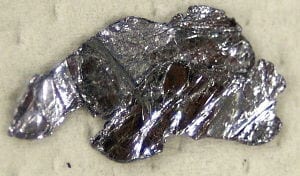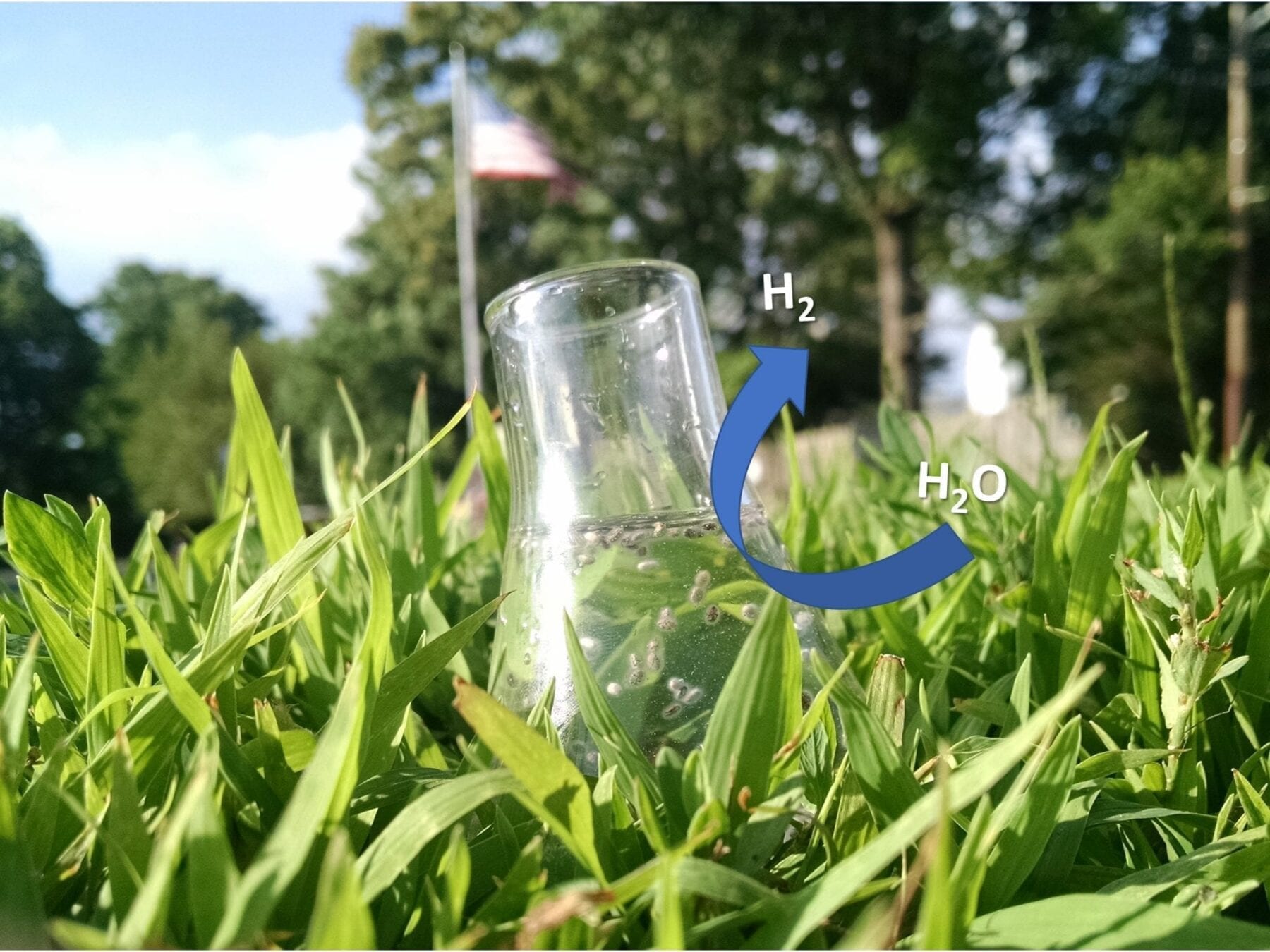
A discovery at the University of Wisconsin-Madison may represent a significant advance in the quest to create a “hydrogen economy” that would use this abundant element to store and transfer energy.
Theoretically, hydrogen is the ultimate non-carbon, non-polluting fuel for storing intermittent energy from the wind or sun. When burned for energy, hydrogen produces water but no carbon dioxide. Practically speaking, producing hydrogen from water, and then storing and using the gas, have proven difficult.
The new study, now published online at the Journal of the American Chemical Society, introduces a new catalyst structure that can facilitate the use of electricity to produce hydrogen gas from water.
Significantly, the catalyst avoids the rare, expensive metal platinum that is normally required for this reaction. (Catalysts speed up chemical reactions without themselves being consumed.)
The material under study, molybdenum disulfide, contains two common elements, notes Mark Lukowski, a Ph.D. student working with associate professor Song Jin in the UW-Madison chemistry department. “Most people have tried to reduce the cost of the catalyst by making small particles that use less platinum, but here we got rid of the platinum altogether and still got reasonably high performance.”
The research group has produced milligram quantities of the catalyst, “but in principle you could scale this up,” says Lukowski. “Molybdenum disulfide is a commercially available product. To control purity and structure, we go through the trouble of synthesizing it from the bottom up, but you could buy it today.”
To make the new material, Lukowski and Jin deposit nanostructures of molybdenum disulfide on a disk of graphite and then apply a lithium treatment to create a different structure with different properties.
Just as carbon can form diamond for jewelry and graphite for writing, molybdenum disulfide can be a semiconductor or a metallic phase, depending on structure. When the compound is grown on the graphite, it is a semiconductor, but it becomes metallic after the lithium treatment. Lukowski and Jin discovered that the metallic phase has far greater catalytic properties.
“Like graphite, which is made up of a stack of sheets that easily separate, molybdenum disulfide is made up of individual sheets that can come apart, and previous studies have shown that the catalytically active sites are located along the edges of the sheets,” says Lukowski.
“The lithium treatment both causes the semiconducting-to-metallic phase change and separates the sheets, creating more edges. We have taken away the limitation from molybdenum disulfide and made the active sites both more pervasive and more reactive.”
The Latest Bing News on:
Hydrogen fuel
- The 3 Top Hydrogen Stocks to Buy in April 2024on April 28, 2024 at 7:00 am
High interest rates seem to be plaguing many sectors of the economy. The electric vehicle space perhaps received the most coverage, but several renewable energy sectors are reeling from elevated rates ...
- Beaulieu: Hydrogen is not the answeron April 28, 2024 at 2:01 am
Solar power and battery storage are clean energy solutions but “clean hydrogen” and “green biofuels” are misnomers used by Granite Shore Power.
- Hydrogen Fuel Cells Market Size Is Projected To Reach USD 16.41 Billion By 2031 | SNS Insideron April 27, 2024 at 9:31 pm
According to SNS Insider, the Hydrogen Fuel Cell M arket valuation to reach USD 16.41 billion by 2031. The estimated CAGR projected for the forecast period of 2024-2031 is 24.87%. The hydrogen fuel ...
- This turquoise fuel is the end of hydrogen: it is obtained from clouds and metalon April 27, 2024 at 5:00 pm
Hydrogen is approaching to its end, and not because they have energized electric cars to increase their range fivefold. Actually, they have done that too, but this is just another piece of bad news ...
- Alberta wants more hydrogen vehicles. Experts say fuel infrastructure needs to come with themon April 27, 2024 at 8:23 am
Experts say building Alberta's hydrogen-fuelled transportation sector means working through a big question: Which comes first, the hydrogen vehicles, or the fuelling stations?
- World’s first hydrogen station for commercial trucks opens – is it too late?on April 27, 2024 at 7:58 am
FirstElement Fuels has opened the world's first large-scale hydrogen fueling station for heavy-duty commercial trucks at Port of Oakland.
- Really Cold Hydrogen Could Bring Driving Range Parity with Dieselon April 26, 2024 at 3:33 pm
The time it takes to fuel a hydrogen-powered fuel cell truck is already on par with diesel. But there is still a yawning gap when it comes to comparable driving range.
- Nikola’s Hydrogen-Truck Fueling Strategyon April 26, 2024 at 11:58 am
Nikola’s Hyla Energy division is using modular hydrogen refueling stations to help bridge the chicken-and-egg gap between supply and demand for fuel-cell-electric trucks.
- California Welcomes First Big-Rig Hydrogen Fuel Station in U.S.on April 26, 2024 at 9:08 am
The country’s first commercial hydrogen fuel station for big-rig trucks is up and running at the Port of Oakland, a step toward what hydrogen proponents see as a clean new future for long-haul ...
- 3 Hydrogen Stocks That Could Be Multibaggers in the Making: April Editionon April 25, 2024 at 3:15 pm
InvestorPlace - Stock Market News, Stock Advice & Trading Tips There are some multibagger hydrogen stocks that investors should have on their ...
The Latest Google Headlines on:
Hydrogen fuel
[google_news title=”” keyword=”hydrogen fuel” num_posts=”10″ blurb_length=”0″ show_thumb=”left”]
The Latest Bing News on:
Hydrogen economy
- The 3 Top Hydrogen Stocks to Buy in April 2024on April 28, 2024 at 7:00 am
High interest rates seem to be plaguing many sectors of the economy. The electric vehicle space perhaps received the most coverage, but several renewable energy sectors are reeling from elevated rates ...
- Beaulieu: Hydrogen is not the answeron April 28, 2024 at 2:01 am
Solar power and battery storage are clean energy solutions but “clean hydrogen” and “green biofuels” are misnomers used by Granite Shore Power.
- This turquoise fuel is the end of hydrogen: it is obtained from clouds and metalon April 27, 2024 at 5:00 pm
The extracted hydrogen can then be used as a clean fuel for transportation, power generation, and industrial applications. Meanwhile, the solid carbon byproduct has its own economic value and can be ...
- World’s first hydrogen station for commercial trucks opens – is it too late?on April 27, 2024 at 7:58 am
FirstElement Fuels has opened the world's first large-scale hydrogen fueling station for heavy-duty commercial trucks at Port of Oakland.
- 4,000% boost! Eco-friendly hydrogen on the horizonon April 27, 2024 at 4:31 am
This breakthrough has profound implications for the establishment of a sustainable hydrogen-based energy economy. Water electrolysis using proton exchange membranes (PEMs) is a green electrochemical ...
- Really Cold Hydrogen Could Bring Driving Range Parity with Dieselon April 26, 2024 at 3:33 pm
The time it takes to fuel a hydrogen-powered fuel cell truck is already on par with diesel. But there is still a yawning gap when it comes to comparable driving range.
- California Welcomes First Big-Rig Hydrogen Fuel Station in U.S.on April 26, 2024 at 9:08 am
The country’s first commercial hydrogen fuel station for big-rig trucks is up and running at the Port of Oakland, a step toward what hydrogen proponents see as a clean new future for long-haul ...
- Nel ASA: Hy Stor Energy places gigawatt capacity reservation for Mississippi Clean Hydrogen Hubon April 26, 2024 at 3:23 am
OSLO, Norway, April 26, 2024 (GLOBE NEWSWIRE) -- Nel ASA (Nel, OSE:NEL) partners with Hy Stor Energy on the Mississippi Clean Hydrogen Hub (MCHH) and receives a capacity reservation for more than 1 ...
- 3 Hydrogen Stocks to Buy on the Dip: April 2024on April 25, 2024 at 3:04 pm
Ian Cooper, a contributor to InvestorPlace.com, has been analyzing stocks and options for web-based advisories since 1999. The post 3 Hydrogen Stocks to Buy on the Dip: April 2024 appeared first on ...
- The first big-rig hydrogen fuel station in the U.S. opens in Californiaon April 24, 2024 at 3:00 am
The Port of Oakland is home to the United States' first commercial hydrogen fuel station for big-rig trucks. It's a step on the road to cleaner trucking.
The Latest Google Headlines on:
Hydrogen economy
[google_news title=”” keyword=”hydrogen economy” num_posts=”10″ blurb_length=”0″ show_thumb=”left”]










